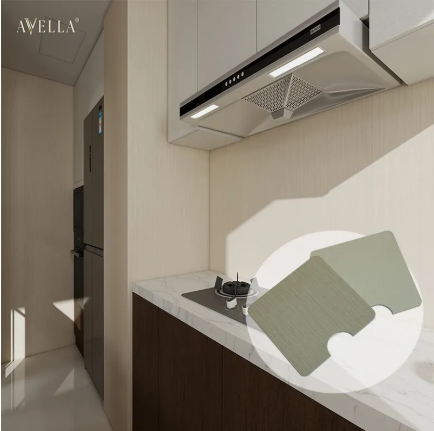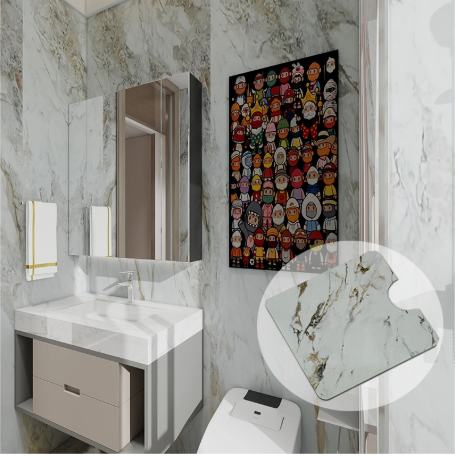Rdzeń technologiczny panelu ścianowego SPC do odporności na wodę
Skład rdzenia z PVC i wapienia o strukturze komórkowej
To, co sprawia, że panele ścienne SPC tak skutecznie chronią przed wodą, to ich technologia rdzenia. Główne składniki to zamkniętokomórkowy PVC zmieszany z wapnikiem, tworząc materiał wyjątkowo odporny na wilgoć, który doskonale sprawdzi się w miejscach, gdzie zawilgocenie jest na porządku dziennym. Chodzi tu na przykład o łazienki czy kuchnie, gdzie wilgoć stale stanowi problem. Budowa tych paneli skutecznie nie wpuszcza wody, ponieważ komórki zamknięte zatrzymują wilgoć zanim przedostanie się ona do wnętrza materiału. Taki projekt nadaje panelom zarówno wytrzymałość, jak i pewną elastyczność, nie pękając przy tym, więc świetnie znoszą uszkodzenia nawet wtedy, gdy poziom wilgotności osiągnie zenit. Producenci dokładnie kontrolują ilość każdego materiału używanego w produkcji, dobierając gęstości tak, aby zapewnić, że panele nie ulegną wygięciu ani nie stracą kształtu po wielu latach ekspozycji na wilgotne warunki.
Jak struktury komórkowe zapobiegają absorpcji wody
Zamknięta struktura komórkowa występująca w płytach ścian SPC tworzy bardzo skuteczną ochronę przed przenikaniem wody, uniemożliwiając wilgoci przedostanie się w materiał i powodowanie jego degradacji z upływem czasu. Badania podobnych materiałów wykazały, że mogą one wchłaniać jedynie 0,1% wilgoci, co jest naprawdę imponujące, biorąc pod uwagę ilość wody, na którą są narażone w wilgotnych warunkach. Przybliżenie tego, co dzieje się wewnątrz tych paneli, pomaga wyjaśnić, dlaczego tak dobrze zapobiegają uszkodzeniom wodnym, zapewniając, by wszystko, co zostało zamontowane, przez wiele lat zachowywało swoją wytrzymałość. To właśnie dzięki tym wytrzymałym strukturom płyty SPC doskonale sprawdzają się w miejscach, gdzie wilgoć zawsze stanowi problem, takich jak ściany w łazienkach czy obramowania kuchennych blatów, na które przez cały dzień trafiają bryzki wody.
Wpływ rdzenia o wysokiej gęstości na oporność na wilgoć
Gęstość rdzenia odgrywa dużą rolę w odporności paneli ściennej SPC na wilgoć. Panele o wyższej gęstości rdzenia lepiej zachowują się pod względem strukturalnym. Mniej się deformują lub wyginają po narażeniu na wodę, dzięki czemu dłużej zachowują estetyczny wygląd. Badania wykazały, że panele o dużej gęstości znacznie lepiej radzą sobie z problemami wilgoci niż lżejsze odmiany. To, co wyróżnia materiały o dużej gęstości, to ich zdolność do jednoczesnego wytrzymywania nacisku i wilgotnych warunków. Dlatego tak dobrze sprawdzają się w miejscach narażonych na stałe działanie wilgoci, takich jak kuchnie restauracyjne czy toalety publiczne. Zachowanie czystego i solidnego wyglądu ma tam szczególne znaczenie, gdzie wygląd jest ważny.
Rola antygrybowych nakładów powierzchniowych
Wiele paneli ścian SPC posiada specjalne powłoki przeciwgrzybiczne, które skutecznie pomagają utrzymać czystość i higienę w miejscach o dużej wilgotności. Te powłoki rzeczywiście zapobiegają wzrostowi pleśni i grzybów, co ma szczególne znaczenie w łazienkach, które są często narażone na wilgoć w trakcie codziennego użytkowania. Badania wykazały, że gdy panele są pokryte takimi powłokami, skutecznie opierają się mikroorganizmom – według niektórych testów skuteczność ta wynosi około 95–98%. Taki poziom ochrony znacząco wpływa na tworzenie bezpieczniejszych warunków życia, szczególnie istotnych dla osób z alergiami lub chorobami układu oddechowego w wilgotnych pomieszczeniach do domu .
Wodoszczelne pieczętowanie i tłamszenie pleśni
Panele SPC są wyposażone w specjalne uszczelki przeciwwodne, które zapobiegają przedostawaniu się wody i wzrostowi pleśni. Większość instalatorów wie, że prawidłowe uszczelnienie krawędzi i spoin ma kluczowe znaczenie w przypadku wilgotnych pomieszczeń. Gdy te słabe punkty zostaną odpowiednio uszczelnione, tworzą solidną linię obrony przed wilgocią napierającą z różnych kierunków. To skutecznie uniemożliwia rozwojowi pleśni, a jednocześnie pozwala zachować integralność konstrukcyjną i estetyczny wygląd przez długi czas. Panele dzięki temu znacznie dłużej wytrzymują nawet po wielu latach ciągłego działania wody.
Wykonanie w Paryjących Prysznicach i Pralniach
Panele SPC bardzo dobrze sprawdzają się w miejscach, gdzie występuje duża wilgotność, takich jak łazienki z parzącymi prysznicami czy komercyjne pomieszczenia pralnicze. Osoby, które zainstalowały te panele, twierdzą, że nadal prezentują się świetnie nawet po wielu latach ekspozycji na wilgotne warunki, dlatego wielu ludzi wybiera je zamiast typowych materiałów do pomieszczeń, które są stale narażone na wilgoć. Testy przeprowadzone przez kilka lat wykazały, że panele SPC są bardziej trwałe niż większość alternatyw, zachowując swój pierwotny wygląd. Po prostu nie wyginają się ani nie zmieniają koloru tak jak inne produkty, które są stale narażone na działanie pary i wilgoci.
Odporność na zwichnięcie w szybkich zmianach wilgotności
Płyty SPC skutecznie opierają się wyginaniu pod wpływem zmian wilgotności, zachowując swój kształt i właściwości użytkowych przez długi czas. Typowe materiały budowlane mają tendencję do ulegania deformacjom przy gwałtownych zmianach wilgotności, co negatywnie wpływa na ich wygląd i funkcjonalność w dłuższej perspektywie. W przeciwieństwie do tych materiałów, płyty SPC pozostają wytrzymałe i stabilne. Doskonale sprawdzają się w miejscach narażonych na wilgoć, takich jak piwnice czy strefy w pobliżu basenów, gdzie para wodna może pojawiać się i znikać w ciągu dnia.
Stabilność termiczna SPC w porównaniu z tradycyjnymi materiałami
Panele SPC są zaprojektowane tak, aby lepiej znosić zmiany temperatury niż większość innych rozwiązań dostępnych na rynku. Kiedy temperatura rośnie lub spada, panele te nie rozszerzają się ani nie kurczą w takim stopniu jak zwykłe materiały drewniane czy laminowane. Badania różnych producentów wskazują, że SPC zachowuje swoją formę nawet w ekstremalnych warunkach pogodowych, które czasem występują. Montażystów cieszy ten fakt, ponieważ oznacza mniejszą ilość problemów z wyginaniem się paneli lub powstawaniem między nimi szczelin w trakcie eksploatacji. Dla budynków położonych w rejonach, gdzie temperatury regularnie zmieniają się w ciągu roku, tego rodzaju stabilność daje długoterminowe korzyści. Panele po prostu dalej dobrze funkcjonują, nie wymagając ciągłego konserwowania czy wymiany.

Długoterminowa płaskość w warunkach wilgotnych
Jedną z rzeczy, która wyróżnia panele SPC, jest ich zdolność do utrzymywania płaskiej powierzchni z upływem czasu, nawet po zainstalowaniu we wilgotnych miejscach lub gdy są narażone na regularne zużycie. Testy wykazują, że te panele ścienne lepiej radzą sobie z wyginaniem i odkształceniom niż większość tradycyjnych rozwiązań, a czasem mogą trwać lata, nie wykazując oznak uszkodzeń spowodowanych wilgocią. Zachowanie płaskiej powierzchni ma duże znaczenie zarówno wizualne, jak i praktyczne, zwłaszcza w łazienkach, kuchniach lub innych pomieszczeniach, gdzie woda ma tendencję do gromadzenia się. Panele nadal ładnie wyglądają i prawidłowo spełniają swoje zadanie w warunkach, które wywołałyby odkształcenie tańszych materiałów.
Technologia szczelnych szwów Snug Click-Lock
Zatrzaski klikające mają ogromne znaczenie przy łączeniu paneli ścianowych SPC bez szczelin, co przyspiesza montaż i zapobiega przedostawaniu się wody do wnętrza. Tradycyjne metody mocowania paneli polegają albo na brudnym klejeniu, albo na przestarzałych złączach piórowych, które nie zapewniają tak skutecznej ochrony przed uszkodzeniami wodnymi. Zgodnie z testami przeprowadzonymi przez wielu producentów, lepiej uszczelnione połączenia zmniejszają problemy wynikające z wilgoci i wydłużają czas eksploatacji paneli przed koniecznością ich wymiany. Dla osób pracujących w pomieszczeniach o podwyższonej wilgotności, takich jak łazienki czy kuchnie, ten mechaniczny system blokujący daje pewność, że ściany pozostaną suche i trwałe przez długi czas.
Strategie zapobiegania wnikaniu kapilarnemu
Wilgoć przedostająca się przez drobne szczeliny w ściany stanowi poważny problem przy instalacji paneli ściennech, zwłaszcza jeśli chodzi o wchłanianie niepożądanej wilgoci. Panele SPC skutecznie rozwiązują ten problem dzięki inteligentnym rozwiązaniom inżynierskim. Panele posiadają m.in. skośne krawędzie i fakturę powierzchni, które skutecznie uniemożliwiają przedostawanie się wody. Badania wykazały, że te rozwiązania doskonale radzą sobie z działaniem sił napięcia powierzchniowego, zapewniając znacznie dłuższą trwałość paneli nawet przy ciągłym oddziaływaniu wilgoci. Budowni instalujący te panele zgłaszają mniejszą ilość problemów z pleśnią i wyginaniem się paneli w czasie, co jest zrozumiałe, biorąc pod uwagę skuteczność barier fizycznych w zatrzymywaniu przenikania wody. Dla osób mieszkających w obszarach o dużej wilgotności, te cechy zapobiegawcze oznaczają spokój ducha, ponieważ wiedzą, że ich ściany nie będą uszkodzone przez ukryte problemy wilgociowe w przyszłości.
Wažność pielęgnacji hermetyzacji krawędzi
Utrzymanie dobrego stanu uszczelnień brzegowych ma kluczowe znaczenie dla zapewnienia odporności na wodę płyt SPC w miarę ich starzenia. Gdy pominięte zostanie to działanie konserwacyjne, woda często przedostaje się przez brzegi, co może prowadzić do wewnętrznego gnicia paneli i ostatecznie wiąże się z znacznie wyższymi kosztami w przyszłości. Większość specjalistów z branży podkreśla, że regularne sprawdzanie tych uszczelnień co kilka miesięcy oraz ich konserwacja w razie potrzeby daje ogromną różnicę. Administratorzy nieruchomości doskonale o tym wiedzą, ponieważ widzieli skutki zaniedbań wynikających z zbyt długiego odkładania tego zadania. Właściciele domów również powinni zwrócić na to uwagę, ponieważ prawidłowo utrzymane uszczelnienia brzegowe nie tylko zapobiegają przedostawaniu się wody, ale także pomagają zachować estetykę ścian przez długi czas. Nikt nie chce przecież wydawać dodatkowych pieniędzy na naprawy problemów, które można było uniknąć dzięki prostym, regularnym kontrolom.
SPC vs. Płytki Ceramiczne w Mokrych Strefach
Płytki ceramiczne zawsze były instalowane od pokoleń w pomieszczeniach wilgotnych, jednak panele SPC oferują naprawdę wiele cennych zalet. Po pierwsze, montaż paneli jest znacznie łatwiejszy, ponieważ są dużo lżejsze niż ceramika, więc nie ma potrzeby używania ciężkich narzędzi czy zatrudniania fachowców. Jeszcze jedną dużą zaletą jest ich przyjemna temperatura w dotyku, w przeciwieństwie do płytek ceramicznych, które zimą mogą być bardzo zimne dla bosych stóp. Testy wielokrotnie wykazały, że panele SPC lepiej znoszą długotrwałe działanie wilgoci, nie pękając jak ceramika, która pod wpływem zmian temperatury może się odkształcać przez lata. Z tego względu wielu budowniczych obecnie preferuje SPC do łazienek i kuchni, gdzie zarówno na wygodę, jak i na odporność na długotrwałe działanie wody zależy.
Przewagi kosztowe i efektywność instalacji
Spójrzmy na liczby, by zrozumieć, dlaczego panele SPC zazwyczaj są tańsze w montażu niż inne opcje. Nie wymagają zaprawy ani specjalistycznego narzędzi, ponieważ pracownicy po prostu mierzą, tną i łączą je ze sobą. Taki prosty sposób skraca czas realizacji i zmniejsza potrzebę zatrudniania drogich specjalistów, co przekłada się na oszczędności w projektach – od niewielkich remontów mieszkania po duże inwestycje komercyjne. Biorąc pod uwagę odporność tych paneli na zużycie w porównaniu do początkowych kosztów, ich wartość jest niepodważalna. W porównaniu do tradycyjnych rozwiązań hydroizolacyjnych, takich jak winyl czy płytki ceramiczne, podłogi SPC oferują znakomitą relację jakości do ceny, nie rezygnując przy tym z jakości.
Trwałość w warunkach długotrwałego narażenia na wilgoć
Panele SPC są zaprojektowane tak, aby znacznie dłużej wytrzymywać w wilgotnych warunkach niż tradycyjne materiały drewniane czy kompozytowe. Badania wykazują, że zazwyczaj trwają około 10 lat dłużej niż inne opcje w wilgotnym środowisku, co oznacza mniejszą konieczność wymiany przez czas i oszczędność środków na naprawy. Wydłużona trwałość czyni je bardzo opłacalnym rozwiązaniem w różnych projektach budowlanych, zwłaszcza przy ograniczonych budżetach. Wybór paneli SPC zapewnia budynkom lepszą ochronę przed uszkodzeniami wodnymi, jednocześnie utrzymując niskie koszty eksploatacji na dłuższą metę.
Rutynowe czyszczenie dla odporności na plamy i wilgoć
Aby płyty ścienne SPC zachowywały swój atrakcyjny wygląd i odporność na plamy, należy stosować podstawowe metody konserwacji. Regularne czyszczenie pomaga im dłużej prezentować się estetycznie i prawidłowo funkcjonować. Większość osób stwierdza, że najlepiej sprawdzają się delikatne środki czystości, ponieważ agresywne preparaty mogą uszkodzić powierzchnię. Należy szukać produktów oznaczonych jako bezpieczne dla delikatnych materiałów – takie produkty skutecznie zwalczają pleśnie i trudne do usunięcia plamy, nie powodując żadnych problemów. Miejsca o dużej frekwencji wymagają oczywiście szczególnej uwagi, ponieważ intensywny ruch przyspiesza zużycie wszystkich powierzchni. Jeśli będziemy przestrzegać tych prostych zasad, nasze płyty SPC powinny służyć znacznie dłużej, zachowując swój wygląd przez wiele lat użytkowania.
Ponowne hermetyzowanie krawędzi dla długoterminowej ochrony
Regularne uszczelnianie krawędzi paneli SPC pomaga w utrzymaniu wilgoci i chroni konstrukcję przed uszkodzeniami. Większość ekspertów zaleca sprawdzanie tych uszczelnień raz w roku, szczególnie w miejscach o wysokiej wilgotności, takich jak kuchnie czy łazienki. Gdy jest to zrobione poprawnie, konserwacja ta wydłuża żywotność instalacji przed wymianą, ponieważ woda nie ma szansy zniszczyć materiału znajdującego się pod powierzchnią. Nakład pracy zwraca się także na wiele sposobów. Panele zachowują swój wygląd, nie ulegają wykrzywieniu ani zniebarwieniu, co ma znaczenie zarówno estetyczne, jak i funkcjonalne. Właściciele domów, którzy podejmują te działania, często zauważają, że oszczędzają pieniądze w dłuższej perspektywie, unikając kosztownej wymiany całych paneli spowodowanej uszkodzeniami wodnymi.
Zajmowanie się zużyciem w strefach o dużym natężeniu plam
Kuchnie i łazienki, gdzie woda stale rozpryskuje się wokół, wymagają szczególnej uwagi, ponieważ narażone są na znacznie większą wilgotność niż inne części domu. Obserwowanie częstotliwości, z jaką woda trafia na te powierzchnie, pomaga w wczesnym wykrywaniu problemów, zanim przerodzą się one w większe kłopoty z panelami. Większość specjalistów rekomenduje dodanie dodatkowych warstw ochrony w miejscach narażonych na chlapanie wodą, aby zwiększyć odporność na uszkodzenia spowodowane wodą. Gdy jest to wykonane poprawnie, tego rodzaju konserwacja pozwala panelom dobrze funkcjonować przez długi czas, a także pomaga im dłużej zachować estetyczny wygląd mimo wilgoci krążącej wokół. Zwracanie szczególnej uwagi na te kłopotliwe miejsca zapobiega stopniowemu pogarszaniu się ich stanu i utrzymuje te cechy, które czynią te panele wartymi posiadania.
Często zadawane pytania
Co sprawia, że panele SPC są odpornymi na wodę?
Panele SPC są odporne na wodę dzięki swojej kompozycji z zamkniętymi komórkami PVC i rdzeniem z wapienia, która minimalizuje absorpcję wody i zatrzymuje wilgoć.
Jak panele SPC zapobiegają pleśni i grzybkom?
Płyty SPC mają antygrybowe nawiercenia powierzchniowe, które hamują rozwój pleśni, oraz zaawansowane hermetyzacje zapobiegające infiltracji wody, co pozwala zachować czystość w środowiskach o wysokiej wilgotności.
Czy płyty SPC są lepsze od płytek ceramicznych dla obszarów mokrych?
Tak, płyty SPC oferują wyższą efektywność termiczną i łatwiejszą instalację w porównaniu z płytkami ceramicznymi, co czyni je bardziej odpowiednimi dla obszarów mokrych.
Jak często powinienem pielęgnować krawędzie paneli SPC?
Zaleca się sprawdzanie i ponowne hermetyzowanie krawędzi paneli SPC raz do roku, zwłaszcza w obszarach o wysokiej wilgotności, aby utrzymać ich wodoodporność.
Czy płyty SPC mogą wytrzymać szybkie zmiany wilgotności?
Tak, płyty SPC są zaprojektowane tak, aby opierać się zwichrowaniu i utrzymywać stabilność strukturalną, nawet pod wpływem szybkich fluktuacji wilgotności.
Spis treści
-
Rdzeń technologiczny panelu ścianowego SPC do odporności na wodę
- Skład rdzenia z PVC i wapienia o strukturze komórkowej
- Jak struktury komórkowe zapobiegają absorpcji wody
- Wpływ rdzenia o wysokiej gęstości na oporność na wilgoć
- Rola antygrybowych nakładów powierzchniowych
- Wodoszczelne pieczętowanie i tłamszenie pleśni
- Wykonanie w Paryjących Prysznicach i Pralniach
- Odporność na zwichnięcie w szybkich zmianach wilgotności
- Stabilność termiczna SPC w porównaniu z tradycyjnymi materiałami
- Długoterminowa płaskość w warunkach wilgotnych
- Technologia szczelnych szwów Snug Click-Lock
- Strategie zapobiegania wnikaniu kapilarnemu
- Wažność pielęgnacji hermetyzacji krawędzi
- SPC vs. Płytki Ceramiczne w Mokrych Strefach
- Przewagi kosztowe i efektywność instalacji
- Trwałość w warunkach długotrwałego narażenia na wilgoć
- Rutynowe czyszczenie dla odporności na plamy i wilgoć
- Ponowne hermetyzowanie krawędzi dla długoterminowej ochrony
- Zajmowanie się zużyciem w strefach o dużym natężeniu plam
- Często zadawane pytania

